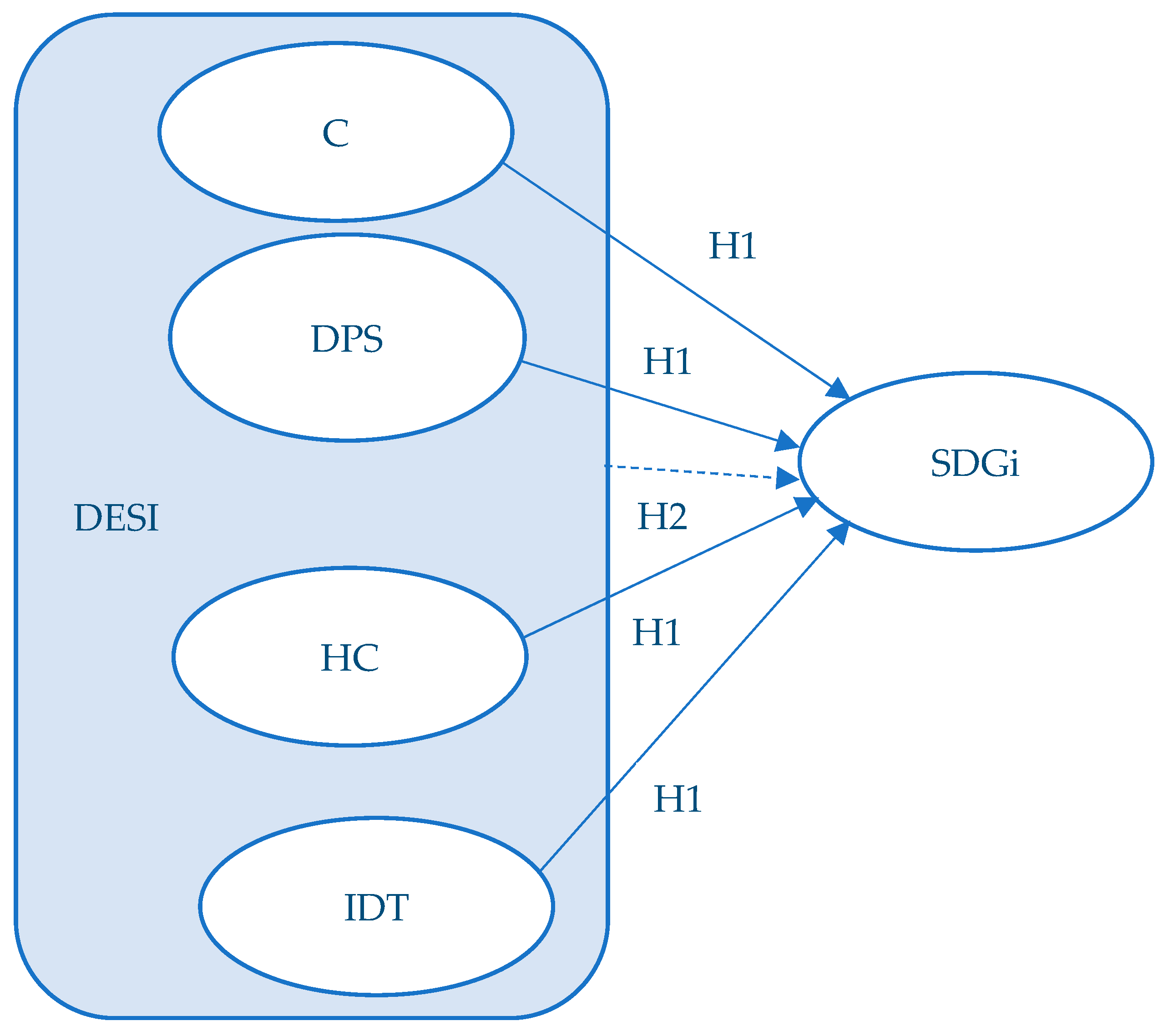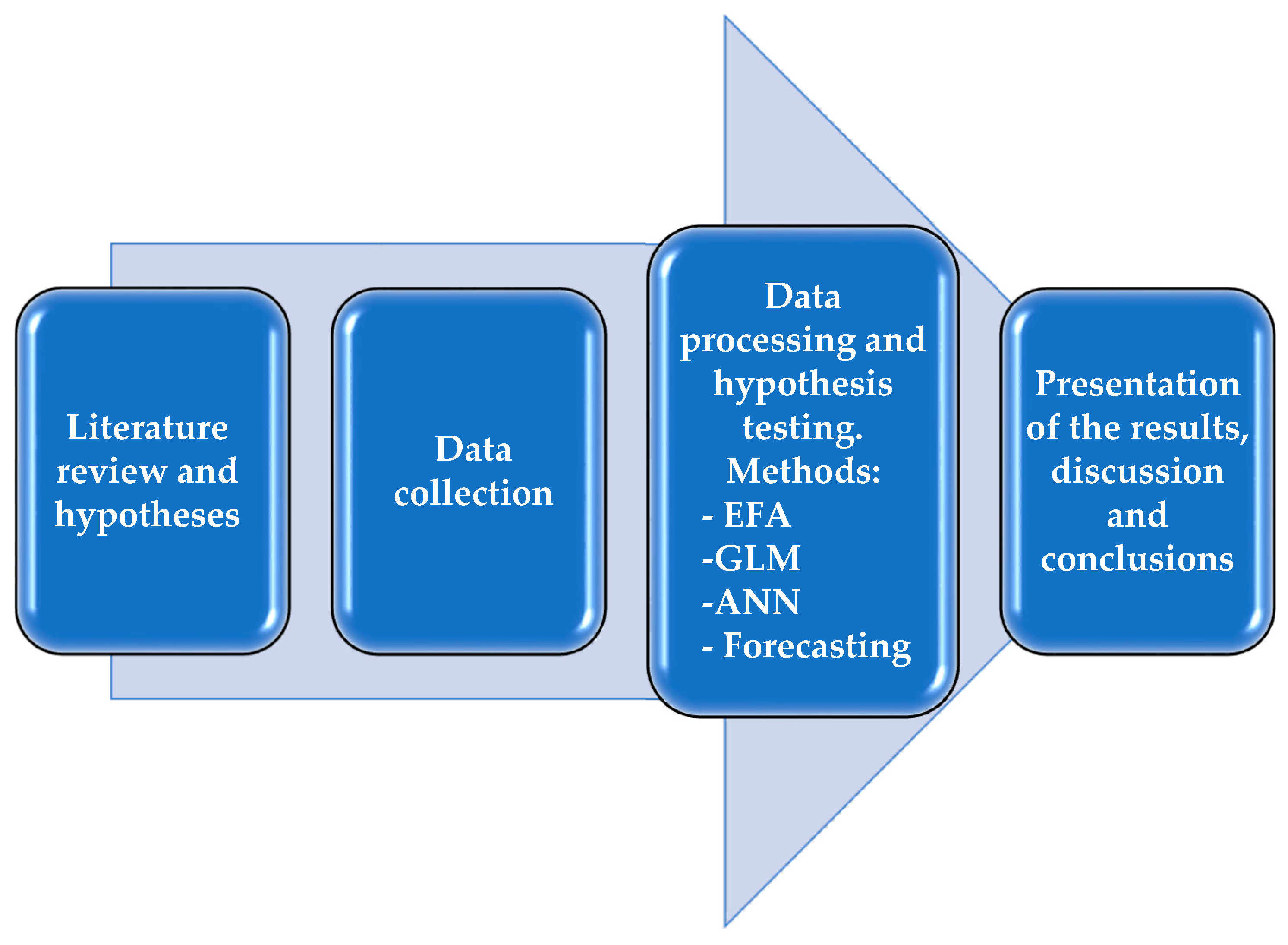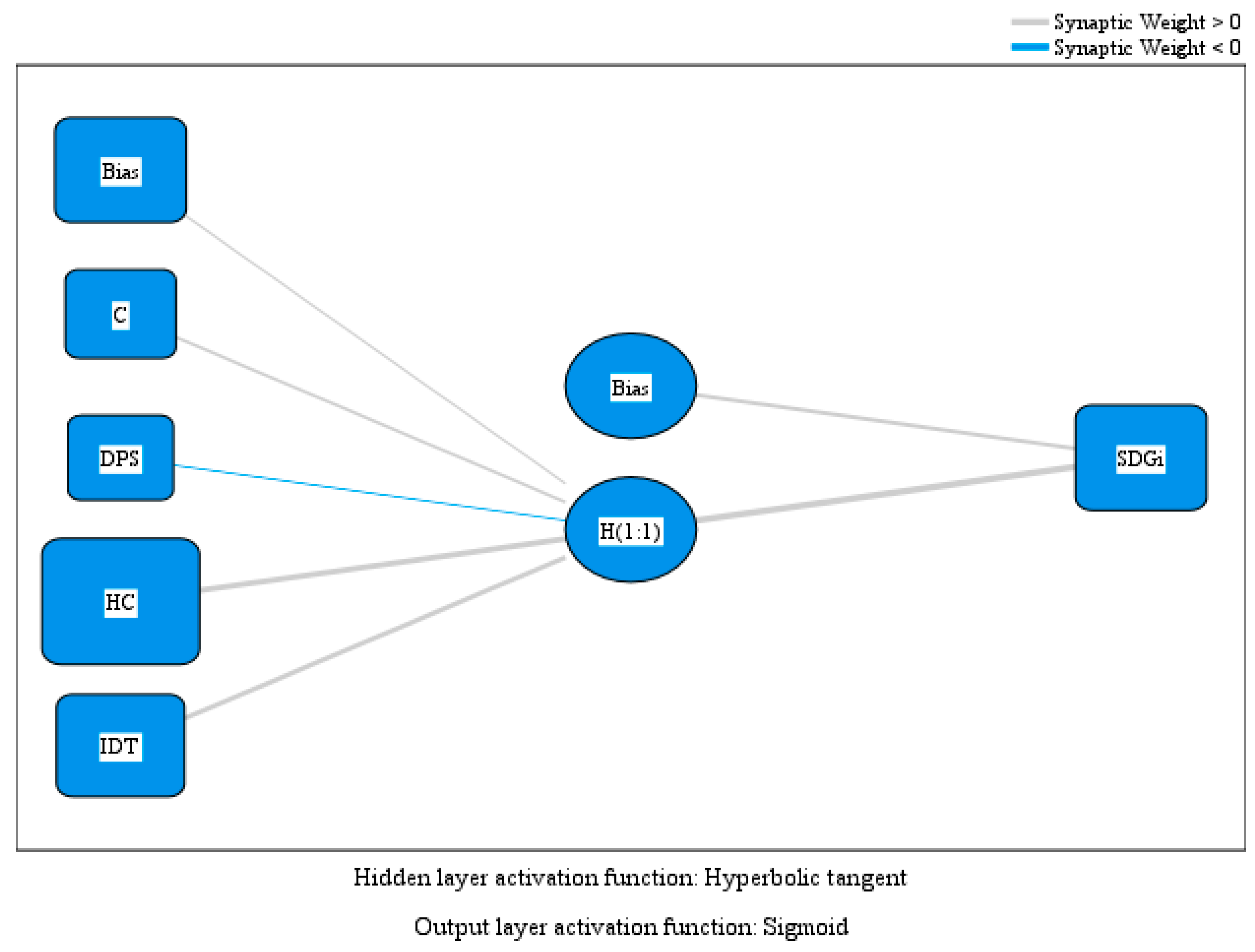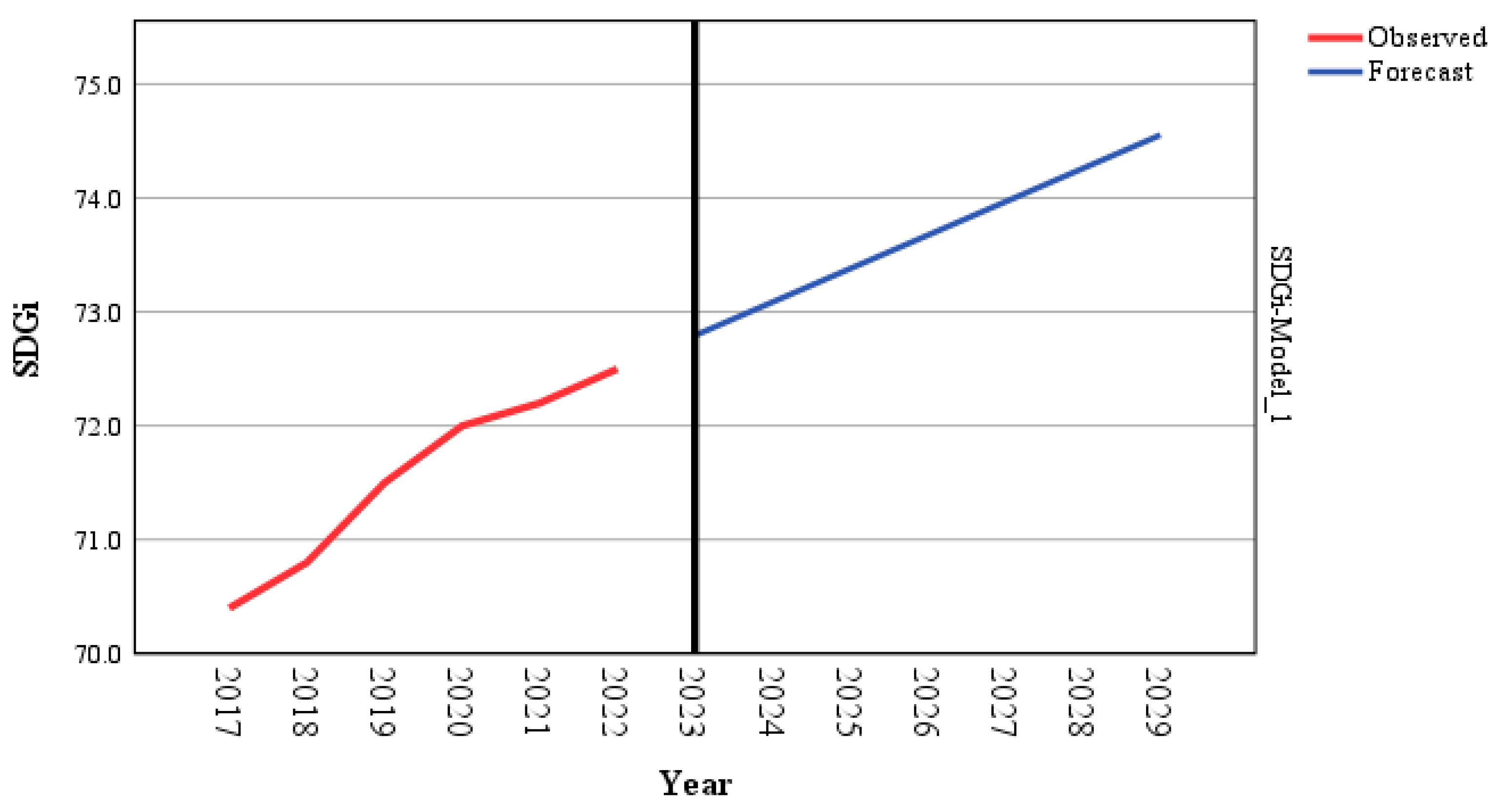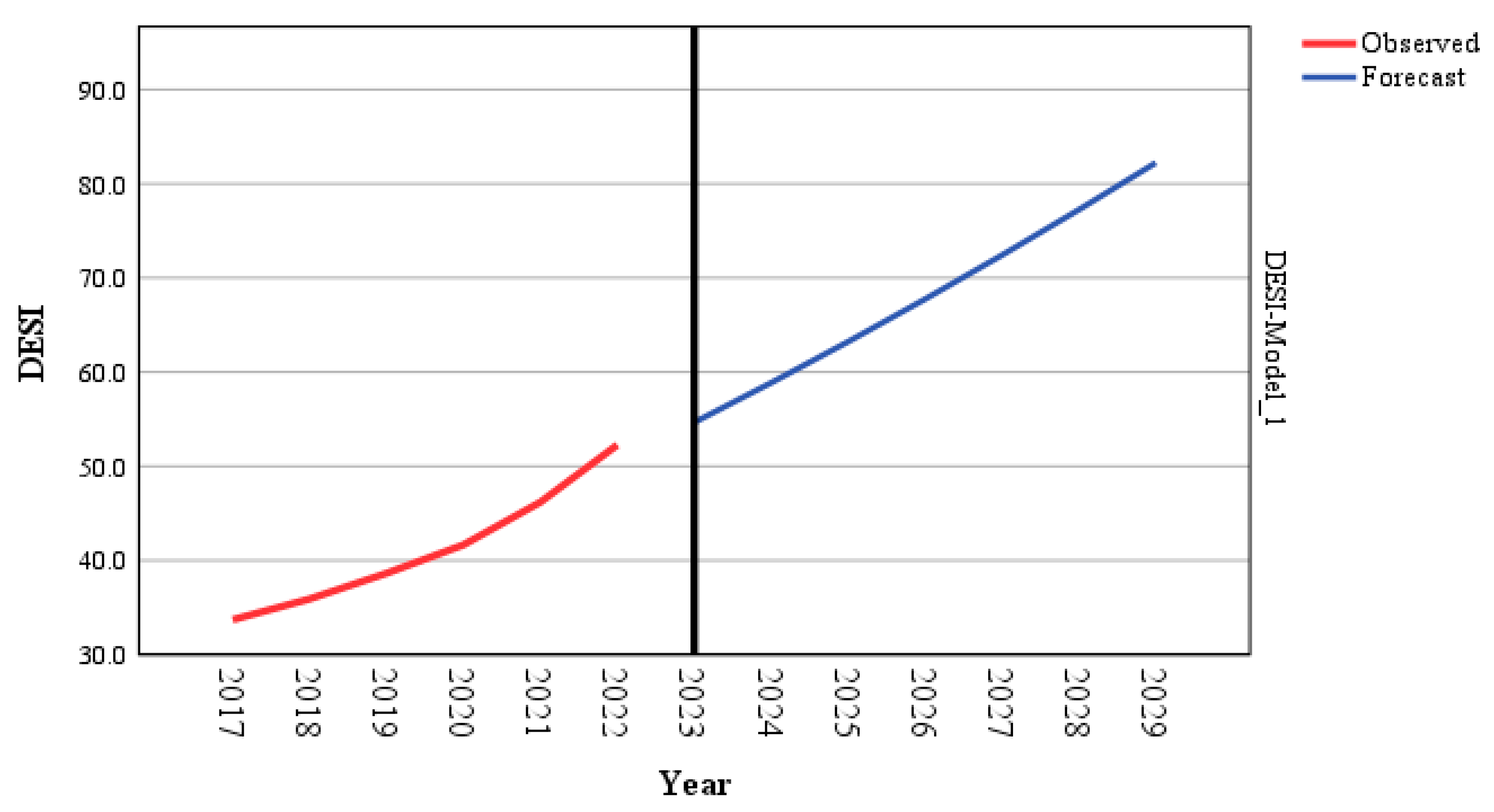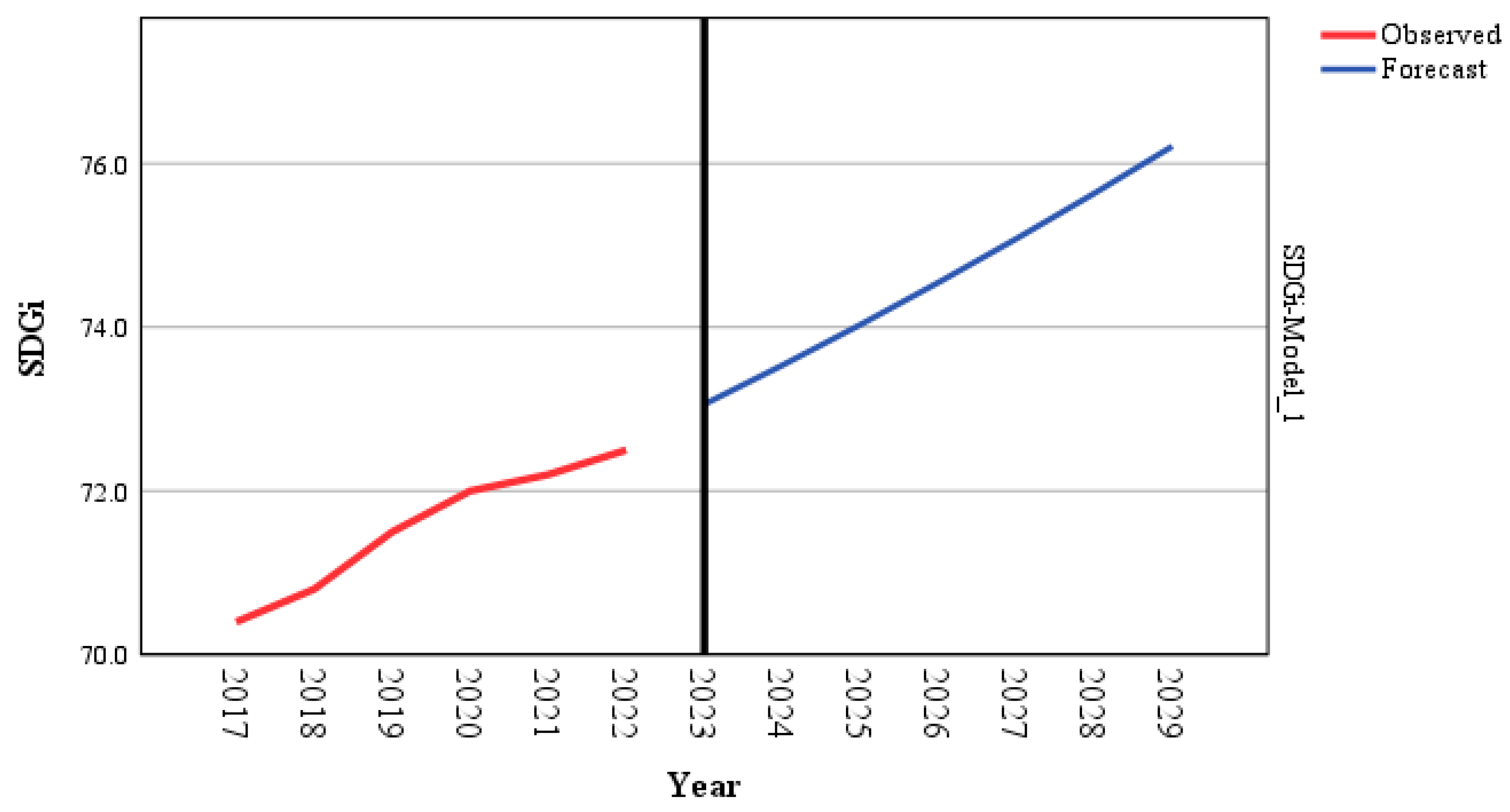4.1. Latent Structure Exploration Through Factor Analysis
Testing hypothesis H1 required a multifaceted approach, integrating exploratory factor analysis, regression techniques, and artificial neural networks to identify linear and nonlinear relationships among the variables.
The exploratory factor analysis applied to our dataset reveals a compelling latent structure, suggesting the existence of a dominant common factor that accounts for a significant proportion of observed variance. The Kaiser-Meyer-Olkin (KMO) test, with a value of 0.791, confirms the adequacy of the sample for this analysis. In contrast, Bartlett’s test, which is significant at
p < 0.001, rejects the null hypothesis of an identity matrix, indicating that there are sufficient correlations among variables to justify the use of factor analysis. The initial correlation matrix highlights significant relationships between DESI components and the SDGi index, with coefficients ranging from moderate to vigorous. Among these, HC and Integration of IDT exhibit the strongest correlations with SDGi, at 0.667 and 0.615, respectively. DPS displays a moderate correlation with SDGi (0.510), whereas C shows the weakest correlation (0.317), indicating potential disparities in how different aspects of digitalization impact sustainability (
Table 3).
The analysis of commonalities reveals that the extracted factor adequately represents the variables, with values ranging from 0.315 for Connectivity to 0.836 for Integration of Digital Technology (
Table 4).
These results suggest that the common factor most strongly explains IDT, whereas Connectivity exhibits a higher specific component, likely due to the varying nature of digital infrastructure across countries. The final factor matrix confirms this interpretation, showing high factor loadings for all variables on the first factor. IDT records the highest loading (0.914), followed by HC (0.875) and DPS (0.856). In contrast, SDGi (0.664) and C (0.561) exhibit moderately strong yet significant loadings. This model highlights the close relationship between digital development, specifically in terms of technological integration, human capital, and digital public services, and performance in achieving sustainable development objectives at the EU member state level.
Explaining the total variance further reinforces the presence of a single dominant factor, accounting for 61.8% of the total variation. This remarkable proportion affirms the strong interconnection between digitalization dimensions and sustainability performance (
Table 5).
The remaining eigenvalues fall below the conventional threshold of 1, suggesting that the data structure is predominantly shaped by this single factor, with minimal contributions from potential secondary factors.
Overall, the factor analysis findings support the notion that digitalization, conceptualized as a multidimensional construct, exhibits a strong structural relationship with sustainability. The fact that a single factor explains such a significant share of variance suggests an underlying mechanism linking these seemingly distinct domains—potentially a combination of institutional capacity, innovation culture, and social cohesion. These insights provide a robust foundation for further investigations into the causal relationships among these variables.
4.2. Regression Analysis of Digitalization’s Impact on Sustainability
The multiple linear regression analysis applied to our study variables provides valuable insights into the relationships between digital economy components and progress toward the SDGs. The resulting model, with an adjusted R
2 of 0.453, explains approximately 45% of the variation in SDGi scores, a substantial proportion that confirms the relevance of digital factors in understanding sustainability dynamics at the national level. The F-test associated with the model, significant at
p < 0.001, indicates that the included predictors explain the variation in the dependent variable better than those without them (
Table 6).
Standardized coefficients (Beta) offer a nuanced perspective on the relative contributions of each predictor. Human Capital (HC) emerges as the strongest determinant of SDGi performance (β = 0.534, p < 0.001), suggesting that investments in digital skills and education constitute the most effective pathway through which digitalization can enhance sustainability. This result underscores the crucial role of the human factor in the digital transformation equation, where the availability of suitable competencies enables the adoption of sustainable practices across various sectors.
The integration of Digital Technology (IDT) also exhibits a significant positive influence (β = 0.242, p = 0.030), albeit to a lesser extent. This indicates that the degree to which digital solutions are implemented in the private sector contributes to improved sustainability performance. This outcome likely reflects how digitalization fosters resource efficiency and sustainable innovation in business environments.
By contrast, the results for Connectivity (C) and Digital Public Services (DPS) are unexpected, as both variables prove statistically insignificant (p > 0.05). This result suggests that merely having digital infrastructure or online public services in place is insufficient to generate measurable improvements in achieving the SDGs. A combination of infrastructure, skills, and practical applications appears necessary for digitalization to unlock its full transformative potential.
These findings emphasize the importance of differentiated approaches in sustainable digitalization policies. They suggest that investments in digital education and professional training, along with incentives for technology adoption in the private sector, may be more effective pathways toward sustainability than simply expanding digital infrastructure or public online services.
4.3. Neural Network Analysis of Digitalization’s Impact on Sustainability
The artificial neural network analysis provides a more nuanced perspective on the intricate relationships between digitalization components and their impact on achieving the SDGs. It essentially confirms the results obtained through traditional statistical methods while uncovering additional dimensions of these relationships.
Figure 3 illustrates the relationships within the ANN model, while
Table 7 presents the estimated model parameters.
The network structure, with a single hidden layer, reveals a relatively simple yet highly effective architecture in capturing the nonlinearities within the data. The coefficients in the hidden layer highlight that Human Capital (HC) holds the most significant weight (0.898), followed by Digital Technology Integration (DTI) at 0.364, while DPS contributes negligibly (−0.014). This model once again highlights the central role of human factors in the equation of sustainable digitalization, suggesting that digital competencies serve as the primary lever through which technology can drive progress toward the SDGs.
An analysis of the importance of independent variables provides a clear hierarchy of factor contributions: HC dominates with a normalized significance of 100%, followed by DTI (43.7%), C (11.1%), and DPS (1.6%). This distribution reveals that, while all DESI components carry some relevance, their influence on sustainability varies significantly. The minimal contribution of DPS may indicate either an underdeveloped digital public services sector across most EU countries or a need to rethink how these services are designed to support sustainable development objectives more effectively.
The output layer parameters, featuring a bias of 0.274 and a weight of 1.166 for the hidden neuron, indicate that the network has learned to integrate information from the hidden layer in a way that maximizes correlation with the target variable. The positive intercept reflects the baseline level of the SDGi, which remains unexplained by the predictor variables included in the model.
Overall, this neural analysis complements and reinforces the conclusions drawn from factor and regression analyses. It further enhances the ability to model nonlinear relationships that traditional methods might struggle to detect, confirming the validity of hypothesis H1. It particularly emphasizes the critical role of investments in human capital as the primary driver of sustainable digital transformation, while suggesting that other digitalization components, although relevant, exert a more limited impact at the current stage of development among EU member states.
4.4. Predictive Modeling of Sustainability and Digitalization Trends
Testing hypothesis H2 required predictive models to estimate the evolution of SDGi based on past trends and anticipated changes in DESI. We apply exponential smoothing within the Brown model (independent variable: time; dependent variable: SDGi) to forecast the development of SDGi using historical data. The exponential smoothing analysis using the Brown model on the SDGi reveals a subtle yet consistent trend of improving sustainability performance across Europe. The model, characterized by a remarkably high alpha coefficient for level and trend (0.958, p = 0.002 < 0.005), indicates a strong dependence on recent values within the time series, reflecting a stable and predictable trajectory for the SDGi during the analyzed period.
Model fit statistics present an intriguing picture: while the conventional R
2 is notably high (0.933), indicating a firm fit to historical data, the stationary R
2 remains close to zero (0.007), suggesting that the SDGi time series is dominated by a trend component with relatively little stationary variability (
Table 8). This result confirms the progressive, incremental nature of improvements in achieving SDGs across the European Union.
The forecasting errors (RMSE of 0.213, MAPE of 0.211%) demonstrate the model’s remarkable accuracy in fitting historical data. At the same time, the negative Normalized BIC value (−2.792) indicates a well-balanced trade-off between model complexity and fit quality. The absence of outliers and residual autocorrelation signals, as indicated by an insignificant Ljung-Box test, suggests that the model effectively captures the fundamental patterns within the time series.
The model’s medium-term projections (2023–2029) depict a moderate linear increase in SDGi (
Figure 4), with estimated values rising from 72.8 in 2023 to 74.6 in 2029 (
Table A1 in the
Appendix A).
This analysis provides valuable temporal insights into the trajectory of sustainability in the EU, complementing other analytical approaches. The steady yet modest upward trend reflects the coordinated efforts of member states to achieve the SDGs while highlighting the necessity of more ambitious interventions to accelerate progress. The model suggests that, in the absence of significant structural shifts in sustainability policies, the EU will continue to experience incremental improvements, which may not be sufficient to trigger substantial qualitative leaps in sustainability performance.
An advanced ARIMA-based approach was employed to forecast DESI trends in national economies, with DESI as the dependent variable and time as the independent variable.
Table 9 presents the ARIMA model fit statistics.
The ARIMA analysis of the DESI within the European context reveals a distinct evolutionary dynamic that contrasts with the more linear trends observed in the SDGi. The identified ARIMA (0,0,0) model, featuring an impressive stationary R2 of 0.974, suggests an exceptionally predictable time series where the square root transformation has optimized data stabilization. This remarkable stability likely reflects Europe-wide efforts to standardize and harmonize digitalization policies, driving this transformative process’s clear and consistent trajectory.
The model parameters, with a significantly negative constant (−557.173) and a strong linear trend (0.279 per year), describe an accelerating upward trajectory for digitalization in Europe. This exponential growth, evident in medium-term projections, illustrates the sustained momentum of digital transformation, which appears to be intensifying year after year. The adjustment statistics, including a low MAPE of 2.102% and a Normalized BIC of 1.062, confirm the model’s high accuracy in capturing historical data patterns.
Forecasts for the 2023–2029 period outline a future where the European digital economy is expected to achieve unprecedented growth (
Figure 5), with DESI values projected to rise from 54.7 in 2023 to 82.2 in 2029 (
Table A1 in the
Appendix A).
If realized, this rapid ascent would signal a profound transformation of European societies while raising critical questions about whether this technological progress can automatically translate into equivalent sustainability improvements, as suggested by the more modest SDGi modeling outcomes.
The ARIMA model describes a rapidly expanding European digital economy, advancing at a pace that likely exceeds other development dimensions. This discrepancy invites more profound reflection on better synchronizing digital and sustainable transformations to ensure a harmonious convergence toward the Agenda 2030 objectives. The results suggest that while digitalization is advancing rapidly, its impact on sustainability remains partially decoupled, requiring more targeted policy interventions to convert technological potential into tangible sustainable development outcomes.
An advanced ARIMA-based approach was employed to investigate the relationship between SDGi and DESI, with SDGi as the dependent variable and DESI as the independent variable.
Table 10 presents the ARIMA model fit statistics.
The ARIMA analysis of the relationship between the DESI and the SDGi offers valuable insights into how these dimensions evolve within the European context. The identified model, featuring a surprisingly simple ARIMA (0,0,0) specification, suggests that the relationship between these variables can be captured through a fundamental linear equation without significant autoregressive or moving average components. However, this structural simplicity conceals a more complex narrative about the nature of digital transformations and sustainable progress.
The key model parameter, a coefficient of 0.007 for DESI (significant at p = 0.006), reveals a positive but unexpectedly modest relationship between digital development and SDG performance. Combined with a relatively large constant (8.185), this result suggests that while digitalization contributes to sustainability improvements, its direct impact appears smaller than anticipated, with most SDGi variation explained by other unmodeled factors.
The adjustment statistics, including an R2 of 0.873 and an MAPE of just 0.348%, confirm the model’s high precision in describing the relationship between the two variables. The relatively narrow confidence intervals (UCL and LCL) surrounding the forecasts suggest strong reliability in medium-term estimates.
Forecasts for the 2023–2029 period depict a steady yet slow SDGi progress (
Figure 6), with estimated values rising from 73.1 to 76.2 (
Table A1 in the
Appendix A).
This incremental growth of approximately 0.5 points per year reflects the relatively slow pace of sustainability improvements influenced by digital economy trends. The nearly parallel confidence intervals across the forecast horizon indicate remarkable stability in this relationship, with no significant signs of acceleration or deceleration.
These findings confirm that digitalization is an essential factor in the sustainability equation, validating hypothesis H2. This analysis highlights the need for policy approaches that extend beyond merely promoting technology, advocating for integrated strategies that fully harness digitalization’s transformative potential for sustainability.
Figure 7 illustrates the dendrogram resulting from the hierarchical cluster analysis applied to the dataset of 27 EU member states. This visual representation captures the structural proximity between countries in terms of their performance across the SDGi, DESI and the four dimensions of DESI. The underlying data used for this analysis are detailed in
Table A2 in the
Appendix A, where each country’s position is presented across key indicators, including human capital, connectivity, digital public services, and integration of digital technologies.
The dendrogram reveals four clearly distinguishable clusters, each reflecting different levels of digital maturity and sustainability engagement. The analysis reveals distinct groupings of EU countries, each reflecting unique patterns in their digital and sustainable development trajectories.
One cluster brings together nations hovering near the EU average in digital performance and sustainability metrics. These countries—neither frontrunners nor laggards—exhibit a measured, balanced approach. Their strength lies in relatively robust human capital and digital public services, though the adoption of advanced technologies remains uneven. For them, sustainability seems less a disruptive leap than a gradual climb, with digital tools serving as steady, if incremental, enablers.
A second cluster, concentrated in Eastern and Southeastern Europe, faces more systemic challenges. Here, digital infrastructure gaps and underinvestment in skills create a dual drag, limiting both technological progress and sustainable outcomes. The disparity is stark enough to signal a policy imperative: without targeted support in connectivity and education, these regions risk being left behind, not just digitally but in their ability to meet broader societal goals.
By contrast, a third cluster—the Nordic states and the Netherlands—exemplifies what happens when digital and sustainability agendas align seamlessly. Their success is not accidental; it is built on high-quality infrastructure, inclusive governance, and a workforce equipped to harness innovation for the public good. In these countries, digitalization is not an end in itself but a means to amplify environmental and social progress.
A fourth, more eclectic group shows flashes of excellence—strong digital public services, pockets of cutting-edge innovation—yet lacks consistency. Some members, like Estonia, punch above their weight in e-governance, while others grapple with uneven adoption. Their trajectories suggest potential, though realizing it will demand sharper policy focus.
This landscape illustrates just how deeply heterogeneous the EU remains in its digital and sustainable trajectories. Regional histories, institutional capacities, and economic structures continue to shape national pathways. This diversity signals the need for flexible and tailored policy frameworks, approaches that respond to where each country stands, what its immediate challenges are, and how it can most effectively harness digitalization in the service of sustainability. Rather than a uniform strategy, the EU needs an architecture of solidarity that recognizes differences while enabling progress.
